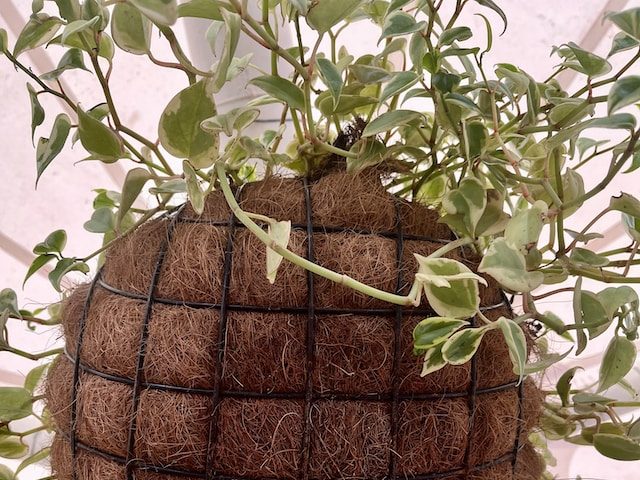White Flowers on a Peace Lily

Instead of the typical green only houseplants, imagine bringing home something with beautiful white flowers. White flowering houseplants can add an elegant and rare touch to your indoor garden and they’ll stand out immediately.
Well, if you’re a bit unsure where to begin with choosing a houseplant with white flowers, we’ve got your back. We’ve curated a list of our top 11 houseplants with white flowers that you can consider for your indoor garden.
In our guide below, we will not only introduce these plants, but also delve into their care regime, blooming factors, varieties of white blooms, and the extra benefits they offer.
Contents
1. The Peace Lily
First on our list is the Peace Lily, also known as Spathiphyllum. These evergreen perennials are renowned for their luscious, dark-green foliage and strikingly elegant white flowers. And despite their premium appearance, they’re pretty low maintenance and a great plant for beginners or busy plant parents.
Caring for Your Peace Lily
Peace Lilies thrive in medium to low light conditions. They prefer evenly moist soil, but be careful! Overwatering can lead to yellow leaves. Also, remember to give them a good wipe occasionally to keep the dust off as their large leaves can be a dust magnet.
Give your Peace Lily fertilizer every couple of months. Only do this, however, during the warmer seasons of spring and summer and when the weather gets chillier, reduce the frequency or stop altogether.
Another great benefit aside from lovely white flowers is that according to NASA’s Clean Air Study, Peace Lilies remove several toxic substances from air!
White Bloom Varieties
While the classic Peace Lily features a single, cream-white bloom, you’ll also find varieties like Spathiphyllum ‘Domino’ with its distinct variegated leaves and white flowers, or Spathiphyllum ‘Picasso’ with pure white blooms adding vibrancy to your indoor collection.
2. Angel Wing Begonia
The Angel Wing Begonia, scientifically known as Begonia coccinea, is a hybrid begonia that stands out for its unique, angel wing-shaped foliage and stunning white flowers.
Originating from Brazil, these plants are prized for their flamboyant foliage and their ability to flower year-round.
The Angel Wing Begonia is not as demanding as it might seem and it can be pretty easy going. It prefers bright, indirect light, and you should use a well-draining soil alongside moderate watering to ensure it doesn’t get waterlogged.
To optimize its growth, maintain a temperature range between 60°F-80°F and they like a strong humidity level so use a spray bottle a couple of times a week to keep this up.
3. Christmas Cactus
Native to the cloud forests of Brazil, these fascinating plants are members of the Schlumbergera family and are known for their flamboyant, bloom-packed festive display of white flowers.
About the Christmas Cactus
The Christmas Cactus is unlike any traditional cactus you’ve probably pictured. It’s a type of forest cactus that prefers a humid climate rather than arid desert landscapes.
Despite its name, the plant doesn’t physically resemble a ‘typical’ cactus. Instead, it has segmented, pendulous branches with soft, round edges and no visible spines.
It gets its name from the beautiful white flowers that bloom during the winter holidays.
Caring for Your Christmas Cactus
Firstly, provide it with bright but indirect light and protect it from direct sun as it can scorch the leaves. Secondly, water it thoroughly when the top inch of soil feels dry to touch. But don’t to overdo it, as too much water can lead to root rot.
During November, the Christmas Cactus prefers cooler temperatures of about 50 to 55 degrees Fahrenheit, which encourages bloom production. Therefore, consider moving it to a cooler location during this period.
Besides bright, indirect light and sufficient watering, the Christmas Cactus likes high humidity.
Create a humid environment by placing a tray filled with pebbles and water underneath the pot. Just ensure that the pot doesn’t directly sit in water.
Additionally, fertilizing it with a high-potassium plant food once every month during spring and summer can contribute to it developing strong white flowers.
White Bloom Varieties
Christmas Cactus commonly blooms in purples, reds, and pinks. But if you’re specifically interested in white flowers, look for Schlumbergera ‘White Christmas’, a variety that boasts stunning white blooms.
4. Cyclamen
The Cyclamen is a unique houseplant known for its heart-shaped leaves and elegant, white flowers that seem to flutter like butterfly wings.
This plant prefers a cool, humid environment and bright, filtered light, so keep it near a window, but not directly in the sun’s path.
- Light: Bright but indirect sunlight.
- Water: Regular but not over-watering. Keep the soil slightly moist.
- Temperature: Ideally between 50 and 65 degrees Fahrenheit in the day, slightly cooler at night.
- Humidity: High humidity, hence placing it near a bathroom window or a humidifier can be beneficial.
5. Gardenias
Native to tropical and subtropical regions, Gardenias are known for their shiny, dark green foliage and captivating, pure white flowers.
The plant is named after Dr. Alexander Garden, a Scottish-born American naturalist. Its flower is shaped like a rosette with multiple layers of petals which is one of our favorites.
Striving in high humidity, it’s necessary to keep the soil well-drained yet consistently moist. If you’re growing gardenias indoors, ensure they get bright, yet indirect sunlight.
Mild winters or a cooler spring are the best times for their white blooms to multiply.
Encouraging White Flowers
Gardenias prefer a slightly acidic soil that contains plenty of organic matter. Many Gardenia species thrive and bloom in hardiness zone 8 to 11. So, unless you live in these zones, you might want to consider keeping them in containers for moving indoors during colder months.
6. Jasmine Plants
Originating from the warm climates of the Old World tropics, Jasmine Plants are a popular houseplant prized for their sweet fragrance and attractive appearance.
They love well-lit conditions but not direct sunlight; in fact, a north-facing window would be perfect.
As for watering, always keep the soil slightly damp and be sure it’s well-draining to discourage root rot (this will lead to soft limp leaves and flowers).
Also, keep the room temperature between 60-75°F (15.5-24°C), as anything outside of this range can harm your plant’s new growth potential and will discourage blooming.
Regular prunings ensure a bushy growth, while a balanced fertilizer every other week during growing season ensures the plant’s vitality.
White Bloom Varieties
Within the vast family of jasmines, several variants produce stunning white flowers.
These include Jasminum polyanthum, known for its robust growth and abundant blooms, Jasminum sambac, aka Arabian jasmine, beloved for its highly fragrant flowers, and Jasminum officinale, or poet’s jasmine, known for its intensely perfumed blossoms.
7. Moth Orchids
Officially named Phalaenopsis orchid but more casually known as Moth Orchids, these plants have elegant white flowers that become the focal point of any room.
About the Moth Orchids
Moth Orchids are popular indoor plants originating from Southeast Asia and Northern Australia.
They use their long, trailing roots to cling onto trees and absorb water in their natural habitats but they are also perfectly content to grow in pots in your home!
Caring for Your Moth Orchids
Caring for Moth Orchids challenges common plant-keeping instincts, but they’re definitely manageable with the right knowledge.
Unlike most houseplants that prefer soil, Moth Orchids love a well-drained, pebble-based planting mix and you should avoid watering them until the planting mix is completely dry.
Remember to keep them in a warm environment as well, as they love temperatures ranging from 60-80°F (15-27°C).
White Bloom Varieties
The classic Moth Orchid that most people envision comprises a tall stalk bearing white, fluttering flowers.
However, newer cultivars such as Phalaenopsis ‘Snow Princess’ also offer an abundance of alluring, pure-white blooms.
8. Oxalis Plant
You’ve probably seen the Oxalis plant, even unknowingly. Known as the ‘shamrock plant’, it’s synonymous with luck. However, there’s more to this plant than just superstition.
Oxalis is a genus that includes over 800 species but we’ll be focusing on the Oxalis triangularis. This variety is often noticed for its vibrant purple, clover-like leaves and small white flowers.
Keep your Oxalis in medium to bright light. A south or west-facing window is usually perfect. However, do protect your plant from harsh, direct sunlight, which can scorch the leaves.
Watering oxalis is a fine balance. Wait until the top inch of the soil is dry before watering again. Overwatering can lead to rot, but under watering can cause the plant to go dormant.
To encourage the growth of their white flowers, add a slow-release fertilizer into the mix during the growing season.
9. Amaryllis
Known scientifically as Hippeastrum, the Amaryllis plant originates from South America’s tropical regions. Not to be confused with other plants named Amaryllis, what we’re referring to here is the indoor blooming species that is popular worldwide.
It’s most recognized for its tendency to bloom in winter, making it a star feature in many holiday decors.
Caring for Your Amaryllis
You’ll be glad to know that the Amaryllis is a relatively easy-to-maintain houseplant. It requires bright light and well-draining soil but also prefers to be slightly pot-bound, so a slightly smaller pot often works best.
The Amaryllis typically flowers in winter and to ensure your plant’s consistent blooming, provide it with a ‘rest’ period of at least two months in the fall where you withhold water completely.
This mimics its natural cycle in the wild and encourages abundant blooming when watering is resumed.
White Bloom Varieties
There are actually over 600 different varieties of Amaryllis plants! Among them, some popular ones with white flowers include Amaryllis ‘Alfresco’, Amaryllis ‘Arctic Nymph’, and Amaryllis ‘Athene’.
10. Lily of the Valley Plant
About the Lily of the Valley Plant
Known scientifically as Convallaria majalis, the Lily of the Valley plant is a woodland white flowering plant that is native to cool, temperate Northern Hemisphere in Asia and Europe.
First cultivated in 1420, it is a highly poisonous plant if ingested, making it not the best choice if you have pets or young children.
Caring for Your Lily of the Valley Plant
This plant prefers a cool, shaded environment with well-draining soil. It is quite hardy and can tolerate poor soil conditions and minimal sunlight but providing a good amount of water without saturating the soil will keep this plant happy and healthy.
When it comes to the soil, it prefers slightly acidic to neutral pH soil – a simple soil testing kit from a local gardening center can help with this.
11. Crown of Thorns Plant
The Crown of Thorns plant or Euphorbia milii, is truly a spectacle to behold. Native to Madagascar, this unique houseplant with its vibrant evergreen leaves and radiant white blooms is sure to catch your eye, although it might seem a bit intimidating due to its thorny stems. Don’t be deterred though because, with the right care, this plant will add a splash of color and intrigue to any home.
About the Crown of Thorns Plant
Besides its beautiful white flowers that appear year-round, it’s a plant that carries a significant amount of symbolism in many cultures.
Some consider it a symbol of good luck, while others associate it with the crucifixion of Christ due to its crown-like shape and thorns.
Caring for Your Crown of Thorns Plant
It’s a tropical, drought-tolerant plant that flourishes under full sun and requires minimal watering. It can withstand a wide range of temperature from as low as 50°F to a high of 90°F, and it’s tolerant to arid conditions which means it won’t mind if you occasionally forget to water it.
And while it loves the sun, it can also do quite well in partial shade. Just avoid extremely dark and cold areas and it’ll be fine!














